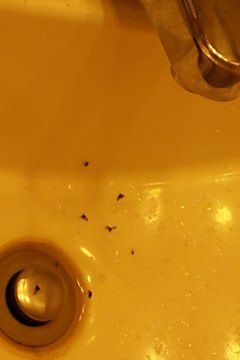How do you get rid of white flies in a garden?

-
You can try a good blast of the hose, making sure you get the underside of the leaves. If that doesn't work, you should use a good, commercially prepared insecticidal soap, making sure the label says it is safe for use on tomatoes. There are plenty of organic options. This is a far better and safer option than a "home remedy" because these products have been tested for their safety and effectiveness. Dish soaps may well be too harsh for plants, stripping essential oils from the leaves that actually makes them more vulnerable to attack and injury.
 Douglas Hunt
on May 21, 2013
Helpful Reply
Douglas Hunt
on May 21, 2013
Helpful Reply -
-
Good Morning @Douglas Hunt ! I did blast my tomato plants last night. It made feel bad too...silly I know. :-) Thank you for your help.
 Brandi Hegerty
on May 21, 2013
Helpful Reply
Brandi Hegerty
on May 21, 2013
Helpful Reply -
-
These sap suckers create havoc because they excrete honeydew as they eat – which in turn attracts sooty mould that turns the leaves black and the plants can't photosynthesize so once they take control, they can do quite a bit of damage. They are most active in warm, humid conditions so won't be a problem all throughout the year but it's good to have organic strategies to use from your toolbox when needed. My philosophy is to work WITH nature, so here are some options for you to consider: 1. White flies do best where the soil is deficient in phosphorous or magnesium. I don't know if you've had a soil test done,but you could probably guess this is part of the problem. Mineral deficiencies can be easily corrected over time by adding the minerals to the soil. Part of my regular maintenance regime is to add 1 tblpsn of Epsom salts (magnesium sulphate) – which is cheap and easily available from the chemist, produce store or supermarket – to 9L bucket or watering can. Water in monthly. You can also add dolomite (calcium & magnesium), rock phosphate (these are the rock minerals I refer to in the above post which provides a balance of soil minerals) or wood ash (if you have a fireplace) to the soil. i.e. tip the scales in your favour by altering the environment so they won't want to live there! 2. Spray with a certified organic oil based product like Eco-Oil that will suffocate them. Check after 2-3 days and spray again if needed. It's useful to have a product like this in your arsenal. 3. Try growing LOTS of nasturtiums under the plants being affected. (See http://themicrogardener.com/20-reasons-to-grow-this-amazing-herb/) 4. Grow pest-repellent plants in your garden to use in homemade sprays or as companion plants to protect against white flies. Penny Woodward has an excellent book (on my bookshelf) called 'Pest-Repellent Plants' which is worth borrowing from the library. She lists many plants including lavender, basils, calendula, onions, pyrethrum, rosemary,thyme, tomatoes, derris, feverfew, quassia, rhubarb and wormwood that are effective against white fly when used in a variety of ways. I won't list them all here but you may want to pick up some ideas from her helpful book. 5. You can also try making your own yellow sticky traps as a last resort as these also attract beneficial insects. The idea is the flying insects are attracted to the colour and get stuck there. Sticky boards are made from lightweight plywood painted yellow or you can use cardboard (cover in yellow contact or paint to make it weatherproof). Use 6 cm x 15 cm or 30 cm x 30 cm as a size guide depending on the area you have to cover. Spread with glue or spray oil to form a sticky surface. Attach with a paper clip and hang or secure to a stake. Replace traps weekly or when full.Traps should be positioned 60 – 70 cm above the plants to be effective if hanging. Yellow sticky traps can be used for white flies, winged aphids and leaf mining flies too. (See http://www.asktheexterminator.com/Pest%20Control%20Supplies/Glue_Traps.shtmlfor photo). Hope this helps!
 The Micro Gardener - Anne
on May 22, 2013
Helpful Reply
The Micro Gardener - Anne
on May 22, 2013
Helpful Reply -
Related Discussions
How do you get rid of fruit flies from the soul of your plant?
There are fruit flies all over my plants.
How do you get rid of sink/drain flies?
I would like to know how to get rid those pesty little sink/drain flies. I've tried baking soda and vinegar, drain cleaners and put plastic over the drains.
How do you get rid of the little black flies on my Christmas cactus I
How do you get rid of flies on the front and back porch?
My front porch and back patio are plagued annually by flies (not just 1 or 2, swarms). Some info, both face east, the front patio is covered, while the back is covere... See more
How do you get rid of yellow on a white fridge?
lThe doors handles on my refrigerator have turned yellow along with the trim around the front where the ice and water come out. How do I get it bright white again?
How do you get rid of aphids in your garden?
There are a gazillion of them. I have never seen it so bad. I have a pic of one, I could not find it when I searched through a ton of images for them. Do I have to ge... See more


